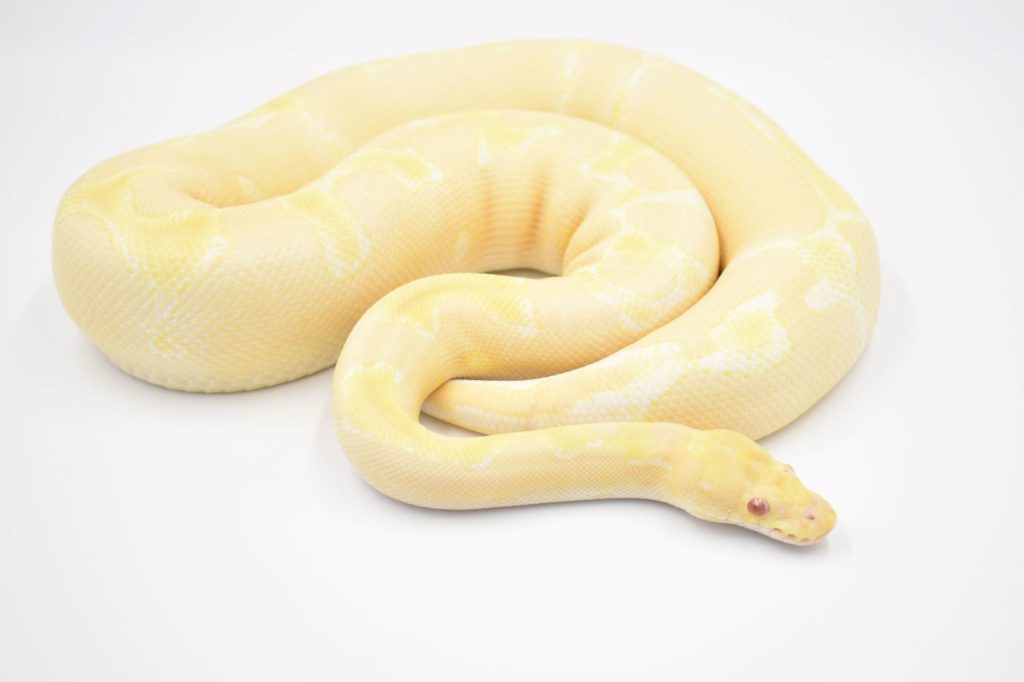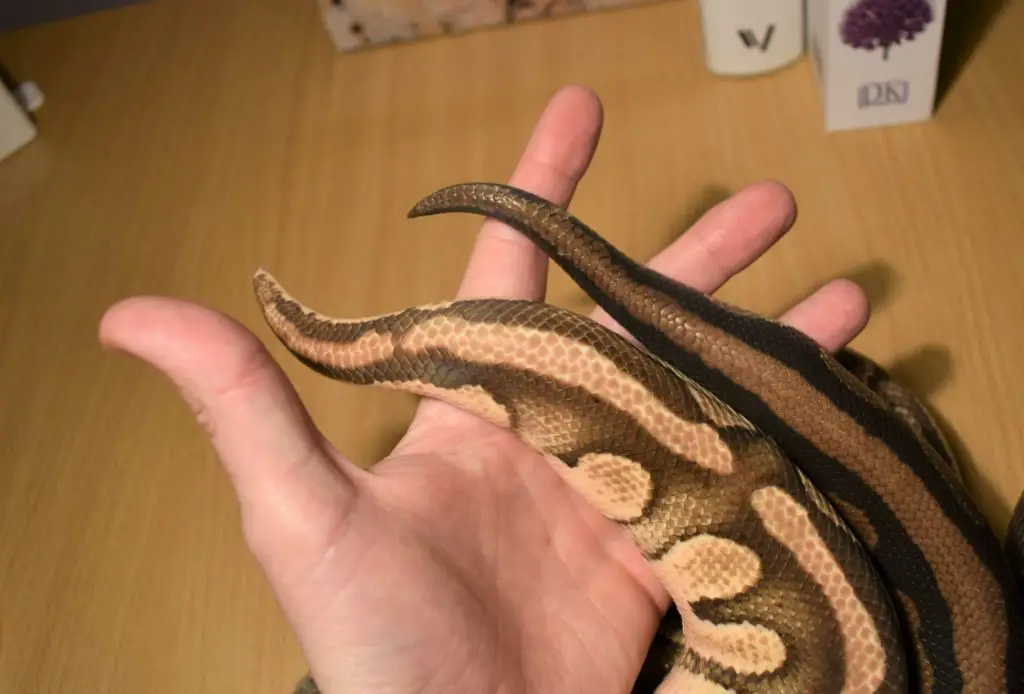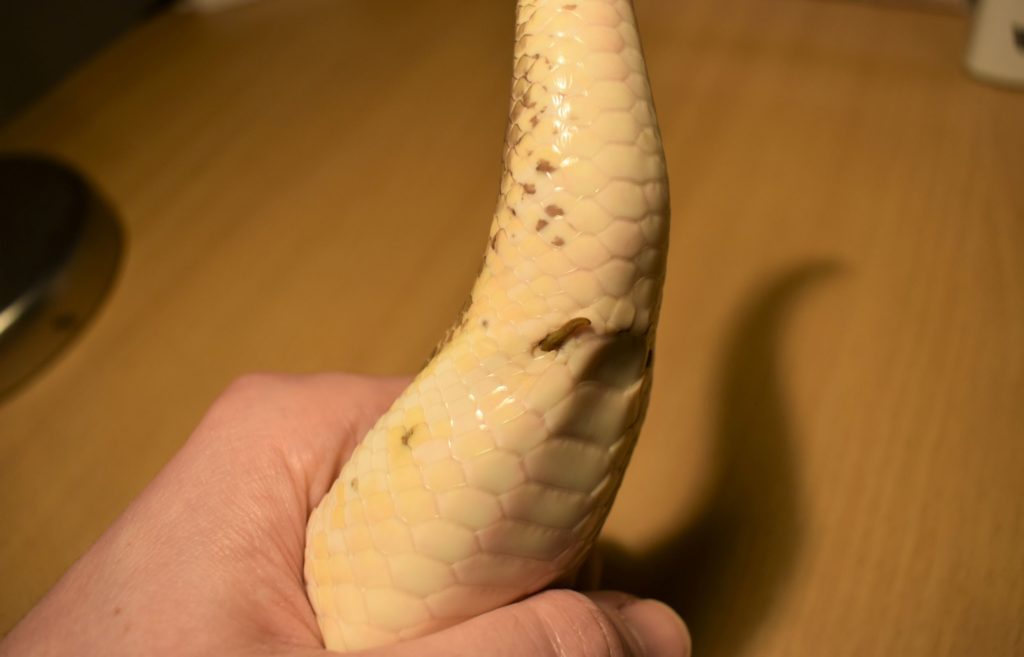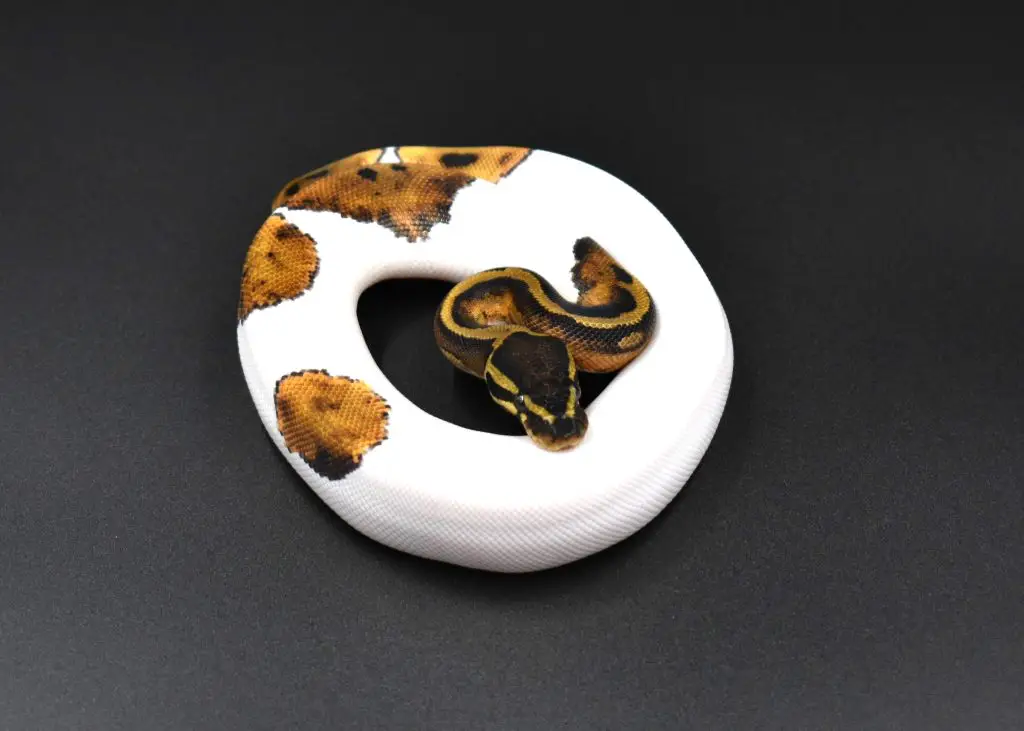To determine a Ball Python’s sex, you will need to pop it, probe it, or get genetic testing. Contrary to popular belief, looking at tail size, spur size, and body size is simply too innacurate. The male organs are stored inside the tail, and there really is no way of detecting them through observation alone.
In this article, we’ll take a look at male vs female Ball Python anatomy and tell you how to sex them with the most accuracy. As always, I’ll be dispelling some ever-popular Ball Python sexing myths along the way!
List of Ball Python sexing methods:
- Observing tail size
- Observing pelvic spur size
- Popping
- Probing
- Observing body size
- Genetic testing
Sexing snakes is not always easy, and the strangely persistent myths about sexing Ball Pythons makes it even harder for beginners. We’re going to look at each method in detail, but – spoiler alert – body size, tail size and spur size are often wildly innacurate!
At this point, it’s also important to say that genetic testing is almost 100% accurate. I’m not discussing it in an in-depth way in this article though because it’s often expensive, and not yet widely available.

Female Ball Python tail vs male
One of the most persistent myths about sexing Ball Pythons was that you could tell their sex by looking at their tails. The belief was that males had longer, broader tails than females. While this may be true for some colubrid species, like Corn Snakes, it really doesn’t apply to Ball Pythons.
Ball Pythons of both sexes have similar sized tails, that are proportionate to their body size. Some males do have larger tails, but others have smaller, skinnier tails. All-in-all, you are almost certain to get their gender wrong if you do it by just looking at the tail!
The reason that many male colubrid species have longer, broader tails is because their sex organs, the hemipenes, are stored in the tail. Female snakes do not have hemipenes, they are a male intromittent organ.
These can be found inside a pouch at the base of tail and are kept inside to prevent injury. Having them inside also stops them getting in the way if a snake is burrowing, constricting, or climbing.
Likewise, Ball Pythons also have two hemipenes which are stored inside pouches on either side of the tail. Unlike most colubrids, however, Ball Pythons are chunky, heavy-bodied snakes. The tails of both sexes are broad and more than large enough to conceal the presence or absence of hemipenes.

Male vs female Ball Python spurs
The next big myth regarding Ball Python gender is to do with their pelvic spurs. These are the spiky little hook-shaped vestigial limbs that you can see at the base of their tails. Inside the body, these spurs are attached to a small vestigial ilium (pelvic girdle) bone that is left over from the time when snakes had legs.
Years ago, a few people claimed that male Ball Pythons always have bigger spurs because they use them for mating. Low and behold, like many other annoyingly incorrect myths, this stuck like glue. For some reason in this hobby, it only takes a couple of people to say something with an authoritative tone and it sticks!
In truth, males do use their spurs for mating. They actually tickle the female with them, though this is very hard to observe. I have to say this is quite a mild form of flirtation when you compare it to some lizards which bite females on the neck, to the point of scarring them.
Unfortunately, though males do indeed make use of their spurs, they aren’t generally larger than those of females. Males and females have cloacal spurs of similar size, though they are highly variable. This is not an accurate way to sex a Ball Python!


Ball Python spurs sticking out
One thing you may notice with your snakes’ spurs is that they sometimes stick out at odd angles. Occasionally, they even fall off. This won’t harm your snake, as the spurs are in fact made of keratin. They won’t suffer any pain from one falling off or find it harder to mate. They may, however, find it annoying that they can’t use it anymore.
In my opinion, the best way to prevent spurs falling off is by maintaining a good humidity level. This will ensure that your snake sheds easily and makes a broken spur less likely.
How to pop a Ball Python
The first thing to know about popping Ball Pythons is that it is way easier to pop juveniles than adults. I never pop adults, purely because I don’t trust it as a reliable method for them. Adults have highly muscular tails and occasionally are able to prevent their hemipenes from being everted.
The result is that you can falsely identify a male as a female. This actually happens on a fairly regular basis. Ask any long-term breeder if they’ve been sold an animal as a female, when it was in fact a male, and they will probably answer yes! For any animal over 6 months of age, I just probe it instead.
Now for baby Ball Pythons, popping is pretty easy. For these guys, I think popping is the better method. It is highly accurate because they are less muscular and popping can be done with little effort or stress to them.
To pop a juvenile Ball Python, you must think of their tail as a tube of toothpaste. The hemipenes are the toothpaste in this case, and to get it out, you need to squeeze it up from the end of the tube. This can be done by holding the body just before the tail, placing your thumb behind the vent (cloaca) and rolling your thumb up the tail.
Does popping a snake hurt it?
If done correctly, popping a snake does not hurt it. If done incorrectly, popping a snake definitely will hurt it. When popping, you should not be applying much force. If you find yourself applying force, you are at risking of hurting and injuring the snake. Ask a breeder for a demonstration instead!

Probing Ball Pythons
In direct contrast to popping, probing is a method that works best for adult snakes. They have larger tails and are less delicate. Nonetheless, this method has a higher degree of accuracy than popping overall.
Probing uses special tools, found in a probing kit, to measure the length of two pouches found inside the tail of Ball Pythons. In males, these pouches are longer because they house the hemipenes.
To probe a snake you insert a correctly sized probe into the vent, just slightly off-centre and in the direction of the end of the tail. The probe, which should be coated in a water-based lubricant, will slide into the pouch until it stops.
When the probe stops, you put your finger on it to mark how far it went, then slowly withdraw. Keeping your finger on the probe, you can then place it next to the vent and measure how many subcaudal scales’ length it was inserted.
In male Ball Pythons, a probe will generally insert to a depth of 7 to 9 subcaudals. In females, the probe stops at 3 to 5 subcaudals.
Does probing a snake hurt them?
As with popping, you should not be applying pressure! In fact, you should apply very little pressure at all with probing. When the probe comes to a gentle stop – that’s it – don’t try to push it further! Please be aware that probing is dangerous if done incorrectly and could even harm your snake’s chances of reproducing in the future.
If you are uncomfortable probing a snake yourself, I recommend taking it to breeder or exotics veterinarian.

Hygiene when probing
Good hygiene is an integral part of Ball Python husbandry, and this applies when handling or sexing animals just as much as it does to maintaining their enclosure.
Because of the invasive nature of probing, there is a possibility of transmitting diseases if proper hygiene isn’t observed. Every time a probe is used it should then be disinfected. There are many veterinary disinfectants available for this, but make sure the probes are also thoroughly rinsed after using these.
Alternatively, you can submerge probes in boiling water for a few minutes to sterilise them. This is the method that I use, and feel is safest. Obviously make sure they have cooled down before using them again!

Male vs female Ball Python size
Female Ball Pythons are generally larger than males. This is down to the fact that they lay eggs, and need a larger body cavity to facilitate this. In fact, if you have a five foot long (1.5m), 4000gram Ball Python it is probably female. Like their tails, though, their body size varies enormously and sometimes independently of sex.
In fact, one of my males is over four foot (1.2m) long and pretty chunky to boot. At a glance, you would expect him to be a female. I also have a fully grown female that is a full foot shorter than him. If I really relied on their size to sex the two, I would have gotten one heck of a surprise when I put them together to breed!
Again, compared to probing or popping, size is not a reliable way of sexing these snakes. That said, it is true that average lengths and weights of females are greater than males – it’s the exceptions to the rule you have to look out for. Check out the table below…
| Age | Length | Weight |
| Hatchling | 10-12in (25-30cm) | 40-70 grams |
| 2 months old | 12-14in (30-40cm) | 90-150 grams |
| 4 months old | 14-18in (35-45cm) | 150-300 grams |
| 6 months old | 18-24in (45-60cm) | 300-600 grams |
| 12 months old | 24-28in (60-71cm) | 600-900 grams |
| 24 months old | 28-36in (71-90cm) | 900-1800 grams |
| 36 months old | 28-48in (71-120cm) | 900-2250 grams |
| Males over 36 months old | 28-42in (71-107cm) | 1200-1800 grams |
| Females over 36 months | 3.5-4.5ft (1.06-1.37m) | 1800-3000 grams |
How do you tell if a Ball Python is male or female? Conclusion
The only reliable methods for sexing Ball Pythons are popping and probing. While each of these methods has its drawbacks, mastering both can help you reliably sex your snakes. In my opinion, it is always best to try to learn both. Body size, tail width/length and spur size should be ignored as they are inaccurate.
If you are not confident with popping or probing, seek the help of a local reptile breeder or exotics veterinarian. Most of us are always willing to help and will help guide you through the process safely.
All-in-all, it’s true that some of the methods can give clues about the sex your Ball Python, but to this day, exotics veterinarians and herpetologists rely almost exclusively on probing, and breeders use probing and popping. Look at just one more table below to see a summary of what methods are in fact effective, and their pros and cons:
| Sexing method | Pros | Cons |
| Observing tail size | Safe | Inaccurate |
| Observing pelvic spur size | Safe | Inaccurate |
| Popping | Acurate | Harder on adults |
| Probing | Extremely accurate | Harder on juveniles |
| Observing body size | Safe | Mostly inaccurate |

FAQ relating to male vs female Ball Pythons
How can you tell the gender of a ball python?
The only highly accurate methods for sexing a Ball Python are probing and popping. If done correctly, each method can quickly determine the animal’s sex, with a high level of certainty. Personality, I have found probing to be most accurate, but I recommend visiting an exotics vet or breeder for help with this to avoid the risk of injuring your pet.
How can you tell a male snake from a female?
In Ball Pythons it’s tough to tell a male from a female without popping or probing. In other snakes though, it’s much easier. Colubrids like Corn Snakes have visually different tails when adults or subadults. The males’ tails are longer, thicker and taper off more slowly than the females.
How old does a ball python have to be to be sexed?
Ball Pythons can be sexed at any age. With my hatchlings, I leave them until they have had their first shed (about a week after hatching) then pop them. At this age they are easy to pop, just like rolling your thumb along a tube of toothpaste with very little pressure. I then probe them once they reach roughly six weeks in age to double check.
Are female or male ball pythons better?
Neither female or male Ball Pythons are better. They reach a similar age, have the same feeding requirements and the same laid-back temperament. The only difference is that some females do get noticeably larger than males, and need a larger enclosure. Again, this isn’t a hard and fast rule – don’t sex them based on this!
How can you tell if a ball python is male or female without probing?
If you can find a company in your country that does genetic testing on reptiles, then this is a way to sex your snake without probing. All you have to do is send in one of its shed skins. The only problem is that this can be expensive, and the companies that do it are few and far between.
More on Ball Python breeding in general:
Back to the Ball Python reproduction page

I have two ball pythons which i rescued from people. I would like to know the gender of each, but after reading your article, have decided that it is not that important if I can’t tell without “probing” them. One snake is 4’9″ & I have been under the belief it is female, bit now not sure. Anyways, if the size is inaccurate to tell, I guess I may never know. Thank you for the informative article none the less!
Hi Laura, thanks for commenting! Honestly, without experience it will be hard to determine their sex with 100% certainty. If you have any local Ball Python breeders though, you could always contact them for help. Many of them are more than happy to do so.
Thanks again for reading, Will